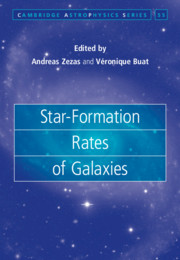Book contents
- Frontmatter
- Contents
- List of Figures
- List of Tables
- List of Contributors
- Preface
- Part I Background
- Part II SFR Measurements
- 5 Star-Formation Rates from Resolved Stellar Populations
- 6 Star-Formation Measurements in Nearby Galaxies
- 7 Continuum and Emission-Line Star-Formation Rate Indicators
- 8 Star-Formation Rates from Spectral Energy Distributions of Galaxies
- 9 Modelling the Spectral Energy Distribution of Star-Forming Galaxies with Radiative Transfer Methods
- 10 Measuring the Star-Formation Rate in Active Galactic Nuclei
- 11 High-Energy Star-Formation Rate Indicators
- Index
7 - Continuum and Emission-Line Star-Formation Rate Indicators
from Part II - SFR Measurements
Published online by Cambridge University Press: 11 May 2021
- Frontmatter
- Contents
- List of Figures
- List of Tables
- List of Contributors
- Preface
- Part I Background
- Part II SFR Measurements
- 5 Star-Formation Rates from Resolved Stellar Populations
- 6 Star-Formation Measurements in Nearby Galaxies
- 7 Continuum and Emission-Line Star-Formation Rate Indicators
- 8 Star-Formation Rates from Spectral Energy Distributions of Galaxies
- 9 Modelling the Spectral Energy Distribution of Star-Forming Galaxies with Radiative Transfer Methods
- 10 Measuring the Star-Formation Rate in Active Galactic Nuclei
- 11 High-Energy Star-Formation Rate Indicators
- Index
Summary
We can trace star formation through a broad variety of observations: photospheric emission from massive stars in the ultraviolet, dust emission in the infrared from grains heated and excited by energetic photons, hydrogen and metal recombination lines from the optical to the infrared, and even free-free continuum and synchrotron emission in the radio domain. The first and foremost constraint for astronomers in estimating SFRs is the ability to obtain adequate observations. For instance, distant galaxies may have emission lines shifted beyond the near-infrared, making them inaccessible from the ground, or the object may be too faint for its free-free emission to be detected. The nature of the observed galaxy and the available instruments therefore strongly guide how we can measure star formation. In the context of this chapter we concentrate on detailing how we can use any observation in star formation tracing bands to measure the SFR as reliably as possible. We will start with theoretical considerations to understand the impact if the assumptions behind each SFR estimator and then discuss the observational constraints.
- Type
- Chapter
- Information
- Star-Formation Rates of Galaxies , pp. 159 - 183Publisher: Cambridge University PressPrint publication year: 2021



